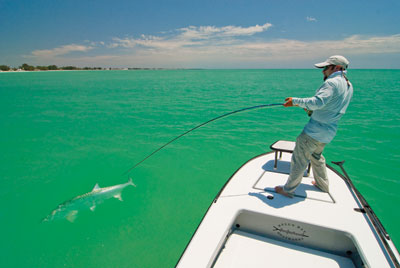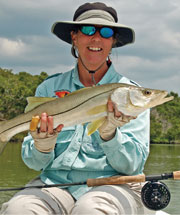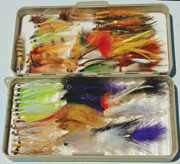
I admit it. I was among the hordes of people attracted to fly fishing after seeing the movie “A River Runs Through It.”
I watched a very young Brad Pitt arcing that line gracefully over the Blackfoot River and thought to myself, “That’s really beautiful. I’d like to do that.”
Me and a million other people, if industry estimates of the newbies who flocked to fly fishing after the movie’s release can be believed, all of us captivated by the allure of standing waist-deep in a cold mountain stream and tracing artistic patterns in the sky with our casts.
Little did I know that my quest to learn fly fishing, on the rivers of northeast Oregon, would lead me right back to where I began – in Tampa Bay.
Unfortunately for the fly fishing industry, most of the newcomers who waded enthusiastically into the sport because of “The Movie” didn’t stick with it.
That is because fly fishing is not easy. It’s a far cry from slinging a live shrimp on a swivel into the water and waiting for a hungry redfish to inhale it. You have to learn how to fly cast, to make your wrists and forearms and elbows do what is necessary to cast 60 feet of slick fly line with a 9-foot graphite stick, effortlessly, and with a tight loop. You have to practice – a lot.

I practiced in my backyard in Tampa, on the street in front of my house (to the amusement of my neighbors),
and in the park at the end of my street. I practiced tying fishing knots while watching TV at night. I learned to tie a Clouser minnow – probably the best all-purpose fly in the world — by myself.
For some reason I still can’t explain, I stuck with it. I am not particularly persistent and I’m certainly not athletic. But I loved being outdoors, on the water, I loved the active nature of fly fishing, and I loved the idea that I was doing something most other people, especially women, weren’t. Most important, I discovered the sheer joy of catching fish on a fly rod.
I began by fly fishing for trout out West and was amazed to discover that people actually fly fished in saltwater, in my own Tampa Bay! Who knew? I joined the Tampa Bay Fly Fishing Club 11 years ago and never looked back. I pestered the guys (there are about 125 men and five women in the club) to give me lessons and take me fishing. Much to my everlasting gratitude, many of them did. One of them became my husband. Our wedding vows included my promise to “always help clean the boat.”
Our honeymoon began with two days of fly fishing for giant redfish in the marshes of Louisiana, where I promptly broke another wedding vow: not to gloat when I caught bigger fish than he did. He still reminds me of that.
I vividly remember the day many years ago when I caught my first snook on fly, a little 15-inch fellow in Cockroach Bay. I still have the photo of me standing in the water with a huge grin, holding the snook, with a massive rat’s nest of tangled fly line swirling around me.
Fishing in Tampa Bay is excellent in general, especially when you consider how developed the bay watershed is and the intense pressure bay fisheries receive . (The Tampa Bay area ranks second only to Dade and Monroe counties in the number of registered boats, and fishing is the most popular form of water recreation here.) Improving water quality in the bay has reaped rewards in increased numbers of trout, redfish and other popular species (snook are still recovering after the bitter freeze of 2010). Tarpon, the hard-fighting “silver kings” of the salt, have made an impressive comeback in Tampa Bay, and are the most coveted quarry of avid fly anglers.

Just about any fish that can be caught with conventional tackle can be caught with a fly rod, with the exception of deep-water grouper and snapper.
Despite this, the number of fly fishers compared to spin or live bait fishermen remains small. According to the Recreational Boating and Fishing Foundation, there are about 6 million fly anglers, and about 20% of them are women. By contrast, about 33 million people engage in spin or bait fishing annually.
Fly fishing will always be a bit of an elitist sport by its nature, but it appears to be gaining steam in Tampa Bay, with good reason.
“Tampa Bay has a multitude of species that can be caught on or near the many shallow water flats, such as snook, redfish, speckled trout, tarpon, ladyfish and jacks,” said Capt. Bryon Chamberlin, a fly fishing guide in Tampa Bay. “These species are the typical ones that come to mind when people think about fly fishing in the waters of Tampa Bay.
“On the other hand, Tampa Bay also has open-water pelagic species that invade its waters on a seasonal basis which can be targeted with a fly rod. These species include Spanish mackerel, king mackerel, cobia, triple tail and little tunny. All provide great sport on a fly rod, so the argument could be made that there is a little bit of everything for everyone to enjoy.”
Rick Fender, a member of the Tampa Bay Fly Fishing Club, notes that Tampa Bay and its tributaries “provide a wide variety of options that don’t exist in such close proximity in very many places elsewhere in Florida.”
For example, you can catch bass and bream in the Hillsborough or Alafia River, snook and reds in Cockroach Bay or Bishop Harbor, and little tunny or tripletail just offshore in the Gulf.
And, while the bay can get very crowded on weekends, “if you can get out during the week it is possible to have a number of great fishing spots all to yourself,” Fender said.
Because fly fishing is a sport of finesse, not brute strength, women can compete on an equal playing field with men. The world’s long distance fly casting champion for 17 years straight was a petite woman named Joan Wulff, who once cast a fly line 161 feet!
So, if you’re one of those guys or gals who have always wanted to give the “long rod” a try, don’t hesitate – even if you’ve never held a fishing rod before. In fact, it’s almost better if you haven’t: You won’t have to unlearn old habits.
Join a local fly fishing club, or go to a local fly shop (see listing below). Fly fishers are an amiable lot, prone to exaggeration like all fishermen, but glad to help those new to the sport.
And, while top-notch fly tackle is seriously pricey ($1000-$1500 for the very best fly rods, reels and line), you can get a good, entry-level set-up for $200-$300. Then, once you know you’re going to stick with the sport, you can upgrade.
Fair warning: Once you’re hooked, it’s an obsession. Our house now boasts “His” and “Hers” rolling fly rod racks, and our vacations almost always involve fishing (in fact, they are often exclusively about fishing).
But I wouldn’t have it any other way. Hope to see you on the water soon!
[su_divider]Originally published Winter 2013
